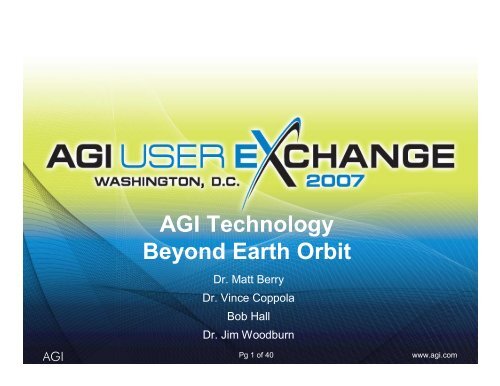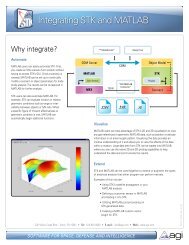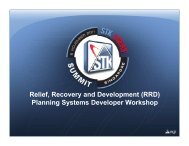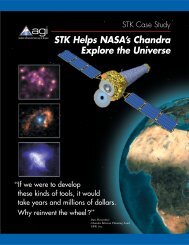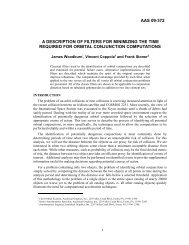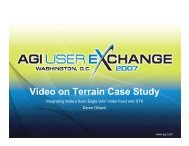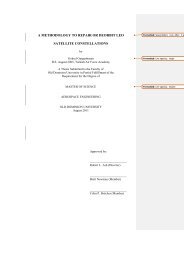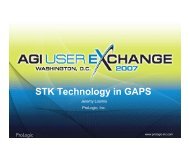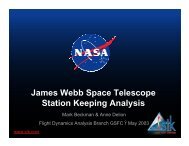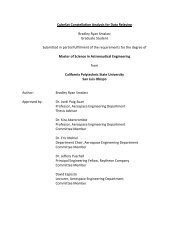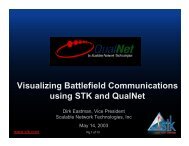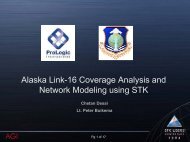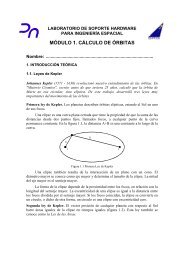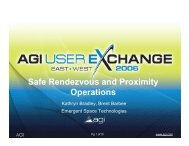AGI Technology Beyond Earth Orbit
AGI Technology Beyond Earth Orbit
AGI Technology Beyond Earth Orbit
- No tags were found...
Create successful ePaper yourself
Turn your PDF publications into a flip-book with our unique Google optimized e-Paper software.
<strong>AGI</strong><strong>AGI</strong> <strong>Technology</strong><strong>Beyond</strong> <strong>Earth</strong> <strong>Orbit</strong>Dr. Matt BerryDr. Vince CoppolaBob HallDr. Jim WoodburnPg 1 of 40www.agi.com
Agenda• Introduction (Woodburn)• Current/Historical Missions (Hall)• Product Enhancements (All)• Central Body Configuration (Coppola)• Light Time Delay Issues (Coppola)• Propagation Issues (Berry)• Closing (Woodburn)<strong>AGI</strong>Pg 2 of 40www.agi.com
Introduction (Woodburn)• Welcome• This is an informal discussion• Introduction of the speakers<strong>AGI</strong>Pg 3 of 40www.agi.com
How did we get here?• 1995 – Generic central body concept–NEAR mission to Eros• 1994 – Navigator (based on Swing-By)• 1997 – Astrogator–MAP• 2005 – Backwards propagation–Messenger• 2006 – Interplanetary improvement• 2007 – <strong>Orbit</strong> determinationContinual Improvement<strong>AGI</strong>Pg 4 of 40www.agi.com
Current/Historical Missions (Hall)• Clementine• AsiaSat 3• MAP (WMAP)• {Contour}• Wind• SOHO• ACE• Lunar Prospector• New Horizons• Messenger• STEREO<strong>AGI</strong>Pg 5 of 40www.agi.com
Recent enhancements to STK(Hall)• Planetary options–Window configuration–Eclipsing bodies• Ground tracks on multiple bodies• Coverage at the poles• PDS terrain• VGT–Drawing orbits in any frame–Use of points for 3D view from/to<strong>AGI</strong>Pg 6 of 40www.agi.com
Recent enhancements to Astrogator(Berry)• Multiple complete gravity fields (STK 8.1.1)• Land – Hold – Launch• Search plugin (3:30 PM talk)• Hpop plugins<strong>AGI</strong>Pg 7 of 40www.agi.com
Recent enhancements to HPOP(Coppola)• HPOP now available for any central body• Gravity field– Re-implemented in STK 8.1.1 – large degree and order– Lunar gravity fields• Tides– Simple Tide Model (Moon)– Permanent and Full tide• Solar Radiation Pressure– Reflection model plugin ODTK 5.1– Multiple eclipse bodies (e.g., <strong>Earth</strong> and Moon)<strong>AGI</strong>Pg 8 of 40www.agi.com
<strong>Orbit</strong> determination (Woodburn)• Capable of OD for lunar and solar orbiters–V5.1, Fall 2007• Generalization of the central body–<strong>Orbit</strong> state–Measurement models• DSN measurement models–DSN Trk-34 tracking data format• Gravity process noise model<strong>AGI</strong>Pg 9 of 40www.agi.com
DSN measurement models• Sequential range (two way)• *Ramped Doppler (two way and three way)• Total count phase (two way and three way)• All based on complete light time solution–Moyer, “Formulation for Observed and ComputedValues of Deep Space Network Data Types forNavigation”*Live data has not been processed<strong>AGI</strong>Pg 10 of 40www.agi.com
Sequential range• Ambiguous two way rangeAmbiguous Range<strong>AGI</strong>Pg 11 of 40www.agi.com
Doppler & total count phase• Counts of received cyclesFrequency ScheduleThree WayEpoch Start FreqFreq Rate….. ………. ………..….. ………. ………..….. ………. ………..….. ………. ………..….. ………. ………..Two WayCycle countingCycle counting<strong>AGI</strong>Pg 12 of 40www.agi.com
Trk-34 tracking data format• Very rich format• Supports many addition types of observables• Sample tracking data (STEREO, MAP)–Sequential range–Total count phase• Currently read only–Simulation of observations to generic obs format<strong>AGI</strong>Pg 13 of 40www.agi.com
Lunar gravity• High degree and order gravity field required–Lack of a dominant term–Missions can fly at very low altitude–Recent gravity modeling improvement• Gravity field not nearly as well known as that forthe <strong>Earth</strong>–Fit span for LS–Process noise for filtersReference: Recent Gravity Models as a Result of the Lunar Prospector Mission<strong>AGI</strong>Pg 14 of 40www.agi.com
Lunar gravity process noise model• Requirement drove revisit of original gravityprocess noise algorithms by Wright• Tools for model generation were reconstructedand improved–Unique coefficients for truncation at each degree–Required data added to gravity file format–<strong>Earth</strong> gravity models will also be updated<strong>AGI</strong>Pg 15 of 40www.agi.com
Sample Lunar OD results• Lunar prospector–Approximately one month of Doppler and range• (28 Feb 1999 – 31 Mar 1999)–At least one long maneuver–Altitude under 40 km<strong>AGI</strong>Pg 16 of 40www.agi.com
LP Position UncertaintyPosition Uncertainty (0.95P)4800.004500.004200.003900.003600.003300.00Process: SmootherSatellite(s): LPTime of First Data Point28 Feb 1999 00:00:13.000 GPSGTwo Sigmas (m)3000.002700.002400.002100.001800.001500.001200.00900.00600.00300.000.000 3000 6000 9000 12000 15000 18000 21000 24000 27000 30000 33000 36000 39000 42000Minutes since 28 Feb 1999 00:00:00.000 GPSGLP 2-Sigmas Radial LP 2-Sigmas Intrack LP 2-Sigmas Crosstrack<strong>AGI</strong>Pg 17 of 40www.agi.com
Doppler Residuals4.00TrackerMeasurement Residual and SigmaTime3.00Measurement Residual and Sigma2.001.000.00-1.00-2.00-3.00-4.001 3001 6001 9001 12001 15001 18001 21001 24001 27001 30001 33001 36001 39001 42001Minutes since 1 Mar 1999 00:00:00.000 GPSG<strong>AGI</strong>Pg 18 of 40www.agi.com
Central Bodies (Coppola)• Celestial Bodies of the Solar System• Settings configured thru text files (*.cb)• Loaded from Install area–And Config area (if CentralBodies folder present)–And Scenario folder (if CentralBodies folder present)<strong>AGI</strong>Pg 19 of 40www.agi.com
Central Bodies (cont’d)• STK Objects (Satellite, Facility, etc.) areassociated with just 1 central body• Set the central body during creation–We don’t allow modification afterward yet–We do ship an HTML utility that can do this<strong>AGI</strong>Pg 20 of 40www.agi.com
Central Bodies (cont’d)• CB used as an indicator–Some default parameter values–Pass Definition–VGT (Position Vector, Velocity Vector, etc.)–2D Graphics (STK 8.1 – now can choose CB’s)–Vehicle Attitude–Frames available for reporting–Shape for Line Of Sight obstruction in Access–Inertial/Fixed frame used for vehicle ephemeris storage–Certain graphics settings<strong>AGI</strong>Pg 21 of 40www.agi.com
CB Settings• Parent• Mu value, System Mu value• Default Gravity Field• Shape (Sphere, Oblate, Triaxial ellipsoid)• Ephemeris Source• Attitude definition• Available propagators• Special settings<strong>AGI</strong>Pg 22 of 40www.agi.com
CB Mu Values• <strong>Orbit</strong>al element conversions–Uses the mu value from the *.cb file [Gm keyword]• TwoBody, J2Perturbation, J4Perturbation–Uses the mu value from the *.cb file• Propagation–mu and other values from the selected gravity file• Third Body Perturbations–Uses the System Mu value (if specified in *.cb file)<strong>AGI</strong>Pg 23 of 40www.agi.com
Gravity FieldsBody<strong>Earth</strong>MoonMarsMercuryVenusJupiterSaturnNeptuneOthersModels984111111NotesSolid/Ocean tides using IERS 2003Simple tide model (<strong>Earth</strong>, Sun)From published papersFrom published paperFrom published paperFrom published paperFrom published paperFrom published paperSimple zonal (J2, J3, J4)<strong>AGI</strong>Pg 24 of 40www.agi.com
Default CB Ephemeris Settings• Sun, Moon, <strong>Earth</strong>, Mercury, Venus, Mars–JPL DE 405 file (405, 403, 200 supported)–Ignores TDT-TDB differences (2 millisec max)–Treats ICRF as J2000• Jupiter, Saturn, Uranus, Neptune, Pluto–JPL DE 405 file, ignores TDT-TDB, ICRF = J2000– Barycentric ephemeris–Mu is planetary value–System Mu is system value (used for 3 rd body perts)• Span: 1960 - 2060<strong>AGI</strong>Pg 25 of 40www.agi.com
Default CB Ephemeris (cont’d)• Moons of–Mars, Jupiter, Saturn, Neptune, Pluto [no Uranus]–Use JPL SPICE files• mar033, jup204, sat077, nep016, plu006• de405–Contains planetary ephemerides too–Considers TDT – TDB difference• Span: 2000 – 2025<strong>AGI</strong>Pg 26 of 40www.agi.com
Modifying CB ephemeris• EphemerisSource JplDE–Available only for major planets, Sun, Moon–ApplyTDTtoTDBCorrectionForDE No [Yes]• EphemerisSourceJplSpice–JplSpiceId ##• Ex: 5 = Jupiter barycenter, 599 = planet center–Additional *.bsp file placed in STKData/Spice directory• Also supported–Analytic (TwoBody with element drift)–External Files (*.e files)<strong>AGI</strong>Pg 27 of 40www.agi.com
Default <strong>Earth</strong> Attitude• Rotation, Nutation, Precession, Pole wander, Equinoxes• Complicated – see Technical help• Nutation: NutationUpdateInterval– STK Default: 1800 secs (30 mins)– ODTK: 0.0• Nutation: IAU1980NutationMethod– STK Default: uses values interpolated from JPL DE file– ODTK: IERS1996• Modeling TEME frame: UseUpdatedEquationOfEquinox– Default: Yes• Inertial Frame: J2000<strong>AGI</strong>Pg 28 of 40www.agi.com
Default Moon Attitude• Interpolates Euler angles from JPL DE file–405, 403 have lunar libration data, not 200• JPL Lunar Recommendation–Use 403 for attitude and ephemeris–LP gravity fields built using these models• Supports IAU2000 frame definition too• Inertial frame: constant rotation from J2000–Mean Of Epoch at J2000 Epoch–Defined using IAU2000 frame definition<strong>AGI</strong>Pg 29 of 40www.agi.com
Default Attitude for other CB’s• IAU2000 Frame definition• Models– Right Ascension and Declination of Fixed Z axis– Rotation about Fixed Z axis• Fourier series, with secular drift terms• Coefficients contained in *.rot file– Same directory as *.cb file• Fixed, Inertial, True of Epoch/Date, Mean of Epoch/Date• Inertial frame: constant rotation from J2000– Mean of Epoch at J2000 epoch<strong>AGI</strong>Pg 30 of 40www.agi.com
Attitude Reference• "Report of the IAU/IAG Working Group onCartographic Coordinates and RotationalElements of the Planets and Satellites: 2000",Celestial Mechanics 82: 83-110, 2002.–Corrected and updated in 2005. (“…Satellites: 2003”)–Also contains size and shape information• True Of Epoch/Date–Ignores Rotation about Fixed Z axis• Mean of Epoch/Date–Ignores Fourier series terms in True of Epoch/Date<strong>AGI</strong>Pg 31 of 40www.agi.com
Adding new CB’s• Create NewCbName.cb file• Edit settings appropriately– Start with a good example: Io, Ceres– DON’T use <strong>Earth</strong>, Sun, Moon as starting point– Really, DON’T use any major planet either to start• Create NewCbName folder– Put in *.cb file (and any *.rot, *.grv files too)• Place folder in CentralBodies directory• If using SPICE, add *.bsp file to STKData/Spice• Restart STK/ODTK<strong>AGI</strong>Pg 32 of 40www.agi.com
Eclipse and Obstruction (LOS)• STK Objects use CB for eclipse/obstruction– Satellites can specify the eclipsing body list• Additional obstructing bodies– Specify each body as Access Constraint• Lighting in the 3D Graphics Window– Doesn’t consider eclipse– Ex.: Io appears lit while located in shadow of Jupiter• Sensor projection– Doesn’t consider obstruction– Projects to object’s CB surface (thru any other CB if need be)<strong>AGI</strong>Pg 33 of 40www.agi.com
Access and Light Time Delay• Signal Sense– Transmit (default) or Receive• Clock Host– Transmit Times or Receive Times– These are the times reported by the tool• Coverage– Normally, grid point is clock host, receiving signal• Aberration– None, Total, Annual• LTD document (pdf) available from Help<strong>AGI</strong>Pg 34 of 40www.agi.com
LTD Issues• Graphics display True positions, not LTD–Except for location of Sun• Sensors projections do not account for LTD• Example: Sensor on Mars, pointed at <strong>Earth</strong>–Must choose pointing sense: Transmit or Receive–At a time of Sensor access, both Mars and <strong>Earth</strong> aredrawn at the same time, not the delayed time–Display near <strong>Earth</strong> won’t agree with computations<strong>AGI</strong>Pg 35 of 40www.agi.com
LTD in Chains• Chains models multi-hop Access–A à B à C à D etc.• Only approximately LTD compliant–Doesn’t apply a consistent clock base–We invalidate the Chain if the LTD of any hop but thelast is too “large”• Customer support à if you need LTD compliance–HTML Tool can help<strong>AGI</strong>Pg 36 of 40www.agi.com
Interplanetary Propagation (Berry)• Choice of origin–Switching cb’s–Use appropriate 3 rd bodies–Include proper ‘indirect’ terms• Matching JPL (Apophis)–Sun-centered–Use all 3 rd bodies–General relativity–Account for TDT / TDB differences<strong>AGI</strong>Pg 37 of 40www.agi.com
HPOP in STK vs.ODTK• ODTK’s <strong>Earth</strong>.cb settings– Nutation Method, Nutation Update Interval• Gauss-Markov processes– STK/HPOP supports propagation• Hidden: No GUI or report– STK/ASTG doesn’t support this• Multiple eclipse bodies– Can’t configure yet in STK/HPOP• Hidden: No Gui (STK 8.2!)– Can configure in STK/ASTG• 3 rd Body mu values– ODTK uses CB file value only (not configurable)• Astro Consistency doc in ODTK Help (HPOP/ASTG)<strong>AGI</strong>Pg 38 of 40www.agi.com
Future direction (Woodburn)• HPOP – ASTG merge• Additional DSN measurement models• Mars GRAM• Additional SPICE integration• What else should we be doing?<strong>AGI</strong>Pg 39 of 40www.agi.com
Questions / Comments?<strong>AGI</strong>Pg 40 of 40www.agi.com


